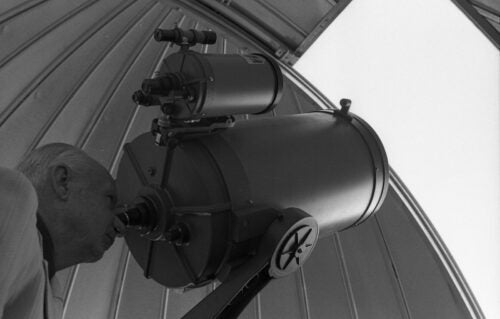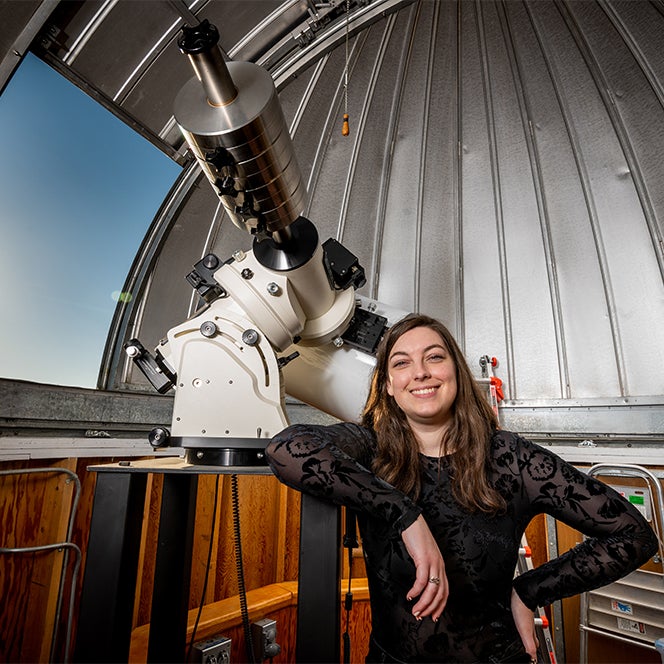In 1977, Boise State University spent $4,500 for a new telescope and $6,000 for a galvanized steel observatory dome atop its science building. Nearly 50 years later, that turned out to be a fine investment. The facility has seen extended use throughout that period, including videotaping a solar eclipse in 1977 and capturing exoplanet transits today.
Now the Department of Physics seeks funding from the community to renovate and modernize the facility so it can continue scientific research and community outreach for another 50 years.
A transformative era
Many aspects of the university we know and love today were forged in the ’70s. Alongside other big changes, Boise State was considering a new Science Education Building at the time. Boise State College, as it was known at the time, was experiencing incredible growth and was running out of lecture halls, laboratories and faculty offices in the old science space (the current Math Building).
Plans started coming together in 1971, and the need for an observatory was clear. In its 1972-73 annual report, the physics department wrote that “an observatory on campus is truly needed for our descriptive astronomy labs,” which had doubled in size since the previous year.

On July 9, 1975, President John B. Barnes broke ground on the new building. Two years later, at the start of the 1977 fall semester, Interim President Richard Bullington toured the building, stopping to examine the brand-new observatory and telescope on its roof.
The facility was an instant hit. It opened to Boise State students and the general public on Oct. 20, 1977. Regular notices appeared in the Arbiter and Idaho Statesman, reminding students and community members that the telescope was open to the public every Thursday night. When the adjoining Education Building was completed in 1978, the observatory was moved to its roof, where it has remained ever since.
Out-of-this-world research
Boise State’s astronomy program has grown considerably in the past 50 years. Today, the physics department has two full-time faculty specializing in astronomy. One of them is Professor Brian Jackson, who uses the observatory platform to study exoplanets – planets outside our solar system – with his student research assistants and a postdoctoral research fellow.
Planets closer to home like Jupiter, Saturn, Mars and Venus are bright, steady points in the night sky. Distant exoplanets, however, are far too dim to see directly, even with extremely powerful earthbound telescopes.
To get around this hurdle, astronomers like Jackson wait until planets pass in front of their host stars. Think of it like witnessing the barest hint of an eclipse at a great distance. The exoplanet disk passes briefly in front of its star, blocking some of the starlight from reaching us. Astronomers measure dimming to get an idea about the planet’s size, orbital period and even composition.
The future of Boise State astronomy

In 2016, Jackson launched the university’s first PonyUp crowdfunding campaign to purchase a new telescope mount and other equipment for the observatory.
The new mount automatically tracks the stars, allowing the department’s powerful 16” telescope to remain locked on a single target for hours at a time. That’s essential for discovering new exoplanets. Astronomers can watch a single patch of sky continuously, waiting to witness a chance exoplanet transit.
The catch? The aging observatory dome can’t keep up with the new mount. It was cutting-edge technology in 1977, but it requires manual rotation to follow the night sky’s movement overhead. Even the most dedicated research assistants are hard-pressed to stay up all night, keeping watch on the observatory.
With their biggest telescope limited by the observatory dome, astronomy faculty and students rely on less powerful instruments for most of their work. Though cutting-edge, these smaller telescopes have more limited sensitivity.
The physics department hopes to fund renovations to the observatory that will bring it up-to-date and let them use the 16” telescope for exoplanet research. That would be a game-changer for Jackson and his students, letting them plan and execute all-night observation sessions from a comfortable control booth inside the Education Building. The end result is higher quality research and hands-on learning experience for students, who get to work with cutting-edge research equipment.
A renovated observatory would also transform Boise State into a hub for astronomy in Idaho. Jackson and his team already host free monthly observing sessions for the public on Fridays. A remote-accessible observatory could open its doors to teachers and researchers throughout the state.
The PonyUp crowdfunding campaign for observatory renovations is open now. Generous friends of Boise State Astronomy, Chris Honcik and Thy Tran pledged a total of $60,000 – half of the funding needed – and encouraged community members to help meet their goal. “We appreciate your consideration of making a gift to help reach the finish line for this $120,000 project,” the campaign said.